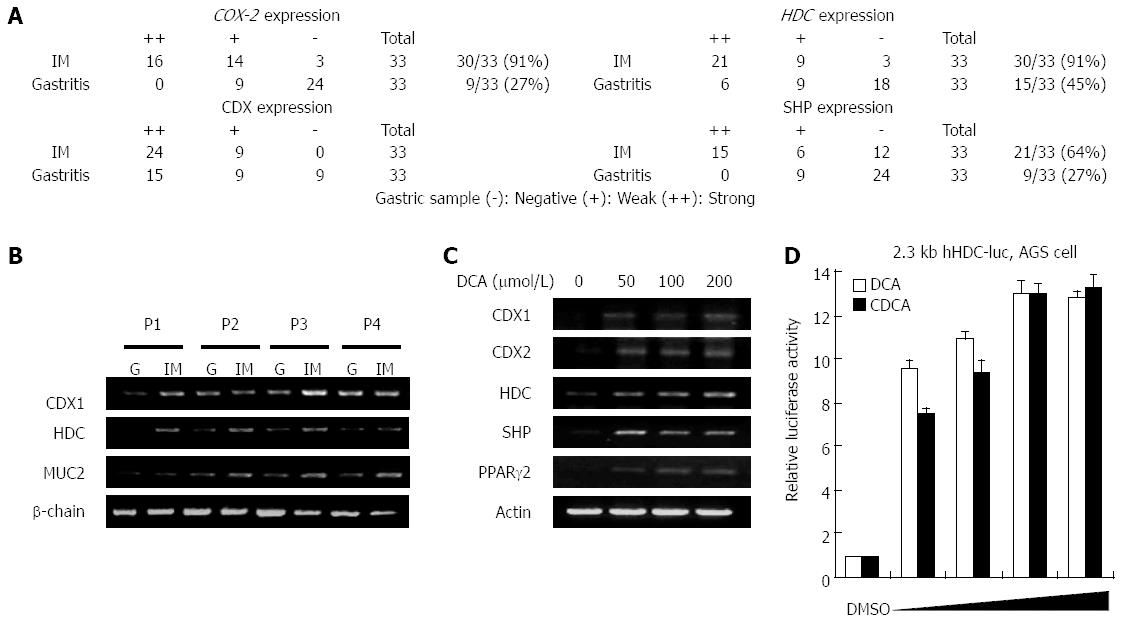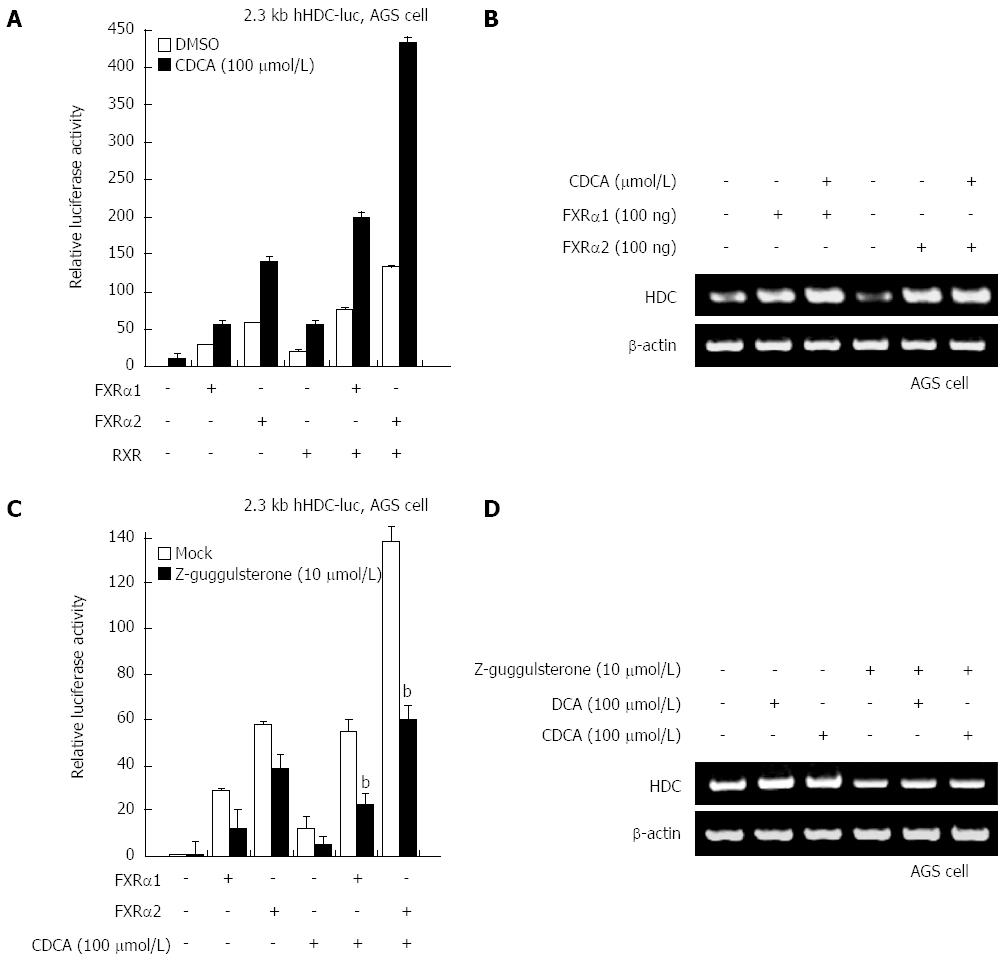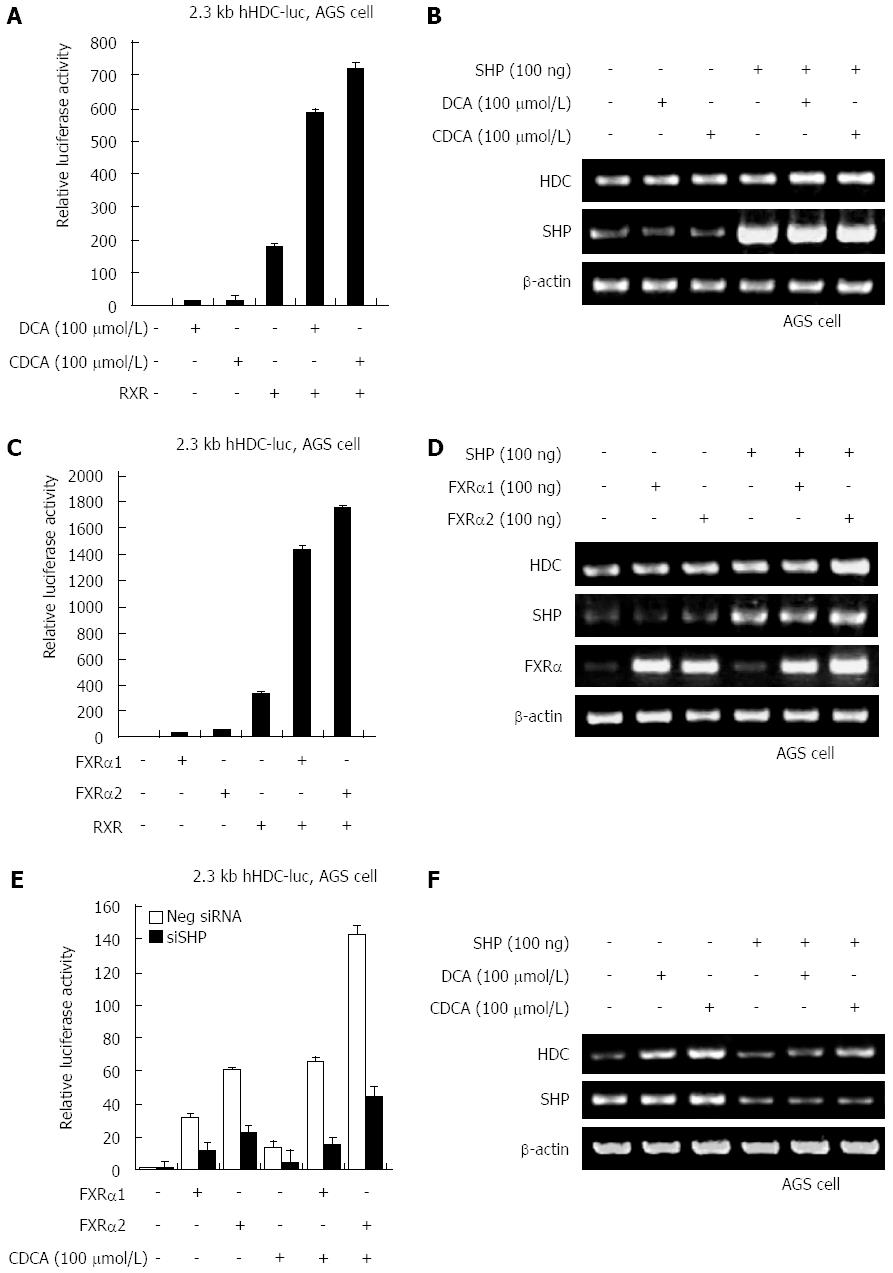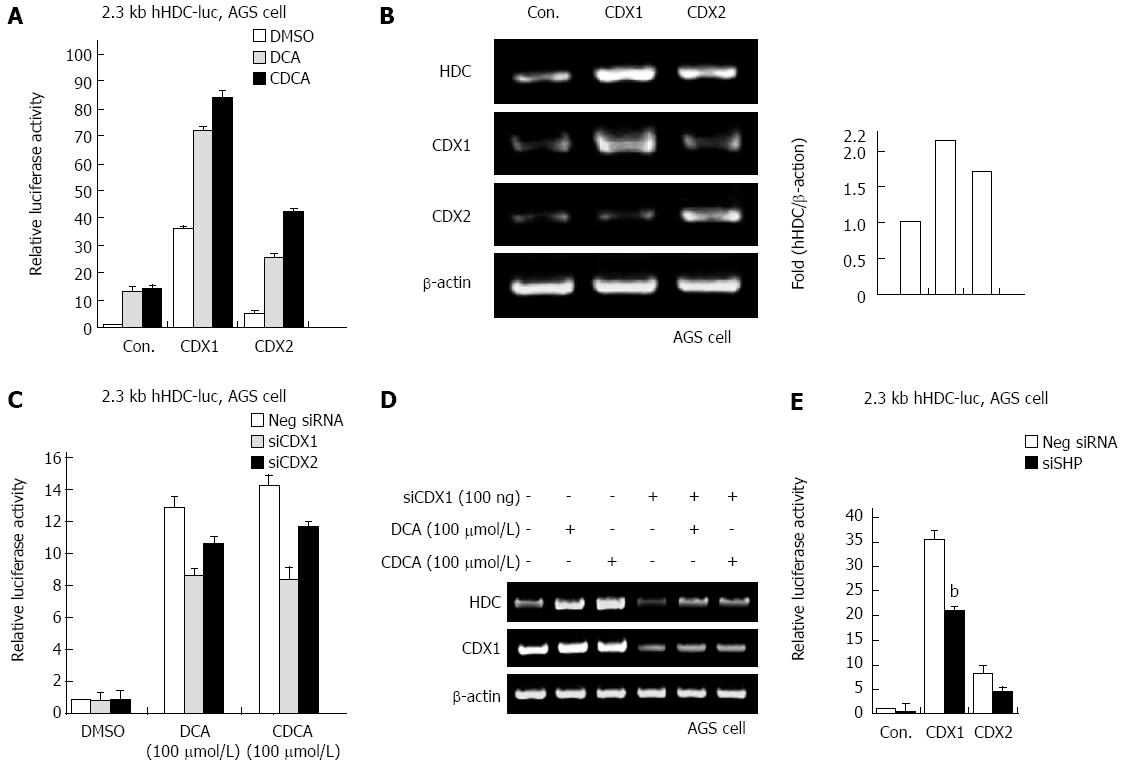Copyright
©2014 Baishideng Publishing Group Co.
World J Gastroenterol. Jan 7, 2014; 20(1): 175-182
Published online Jan 7, 2014. doi: 10.3748/wjg.v20.i1.175
Published online Jan 7, 2014. doi: 10.3748/wjg.v20.i1.175
Figure 1 Relative expression levels of histidine decarboxylase in gastritis patients with or without intestinal metaplasia and bile acid-treated cells.
A: mRNA expression patterns of cyclooxygenase 2 (COX-2), caudal-related homeobox family (CDX1), small heterodimer partner (SHP), and histidine decarboxylase (HDC) in 11 patients. Tissue samples for molecular analysis were collected from patients undergoing gastritis surgery or endoscopy for diagnosis of gastric disease. Numbers represent patient numbers showing the same intensity of mRNA expression; B: Total RNA was prepared from four gastric mucosa samples representing gastritis and intestinal metaplasia, after which CDX1, HDC, and mucin (MUC)2 mRNA levels were measured by reverse transcription-polymerase chain reaction (RT-PCR) with β-actin as a loading control; C: MKN45 cells were maintained either under control conditions (DMSO) or in the presence of various concentrations of bile acids (deoxycholic acid, DCA) for 24 h. Total RNA was prepared from the cells, after which mRNA levels of CDX, HDC, SHP, and peroxisome proliferator-activated receptor (PPAR)γ2 were assessed by RT-PCR; D: Human gastric adenocarcinoma (AGS) cells were transfected with the 2.3 kb HDC-luc promoter construct and maintained either under control conditions (DMSO) or in the presence of various concentrations (10, 20, 50, and 100 μmol/L) of bile acids (DCA; chenodeoxycholic acid, CDCA) for 24 h. Cells were harvested and analyzed for luciferase activity. The experiment was repeated three times in triplicate.
Figure 2 Farnesoid X receptor mediates bile acid-induced increase in histidine decarboxylase in gastric cancer cells.
A: Human gastric adenocarcinoma (AGS) cells were cotransfected with the 2.3 kb histidine decarboxylase (HDC)-luc promoter construct and the indicated plasmids and then maintained either under control conditions or in the presence of chenodeoxycholic acid (CDCA). Cells were harvested and analyzed for luciferase activity; B: AGS cells were transfected with farnesoid X receptor (FXR)α1/2 expression plasmid and maintained either under control conditions or in the presence of CDCA. Total RNA was prepared from the cells, after which HDC mRNA levels were evaluated by reverse transcription-polymerase chain reaction (RT-PCR); C: AGS cells were cotransfected with the 2.3 kb HDC-luc construct and FXRα1/2 expression plasmid or in the presence of CDCA. Cells were then maintained either under control conditions or in the presence of z-guggulsterone. Cells were harvested and analyzed for luciferase activity. bP < 0.01 vs mock transfectants; D: AGS cells were treated with deoxycholic acid (DCA) or CDCA. Cells were maintained either under control conditions or in the presence of z-guggulsterone. Total RNA was prepared from the cells, after which HDC mRNA levels were determined by RT-PCR.
Figure 3 Small heterodimer partner is associated with bile acid-induced histidine decarboxylase transactivation.
A: Human gastric adenocarcinoma (AGS) cells were cotransfected with the 2.3 kb histidine decarboxylase (HDC)-luc promoter construct and small heterodimer partner (SHP) expression plasmid in the presence of deoxycholic acid (DCA) or chenodeoxycholic acid (CDCA). Cells were analyzed for luciferase activity; B: AGS cells were cotransfected with the 2.3 kb HDC-luc promoter construct and expression plasmids for farnesoid X receptor (FXR)α1/2 and SHP. Cells were analyzed for luciferase activity; C: AGS cells were cotransfected with the 2.3 kb HDC-luc promoter construct and FXRα1/2 expression plasmid in the presence of CDCA. Cells were analyzed for luciferase activity; D: AGS cells were transfected with SHP expression plasmid in the presence of DCA or CDCA. Total RNA was prepared from the cells, after which HDC mRNA levels were determined by reverse transcription-polymerase chain reaction (RT-PCR); E: AGS cells were transfected with expression plasmids for FXRα1/2 and SHP. Total RNA was prepared from the cells, after which HDC mRNA levels were determined by RT-PCR; F: AGS cells were transfected with SHP siRNA construct in the presence of DCA or CDCA. Total RNA was prepared from the cells, after which HDC mRNA levels were determined by RT-PCR.
Figure 4 Bile acid induces histidine decarboxylase expression by caudal-related homeobox 1, which is mediated by small heterodimer partner.
A: Human gastric adenocarcinoma (AGS) cells were cotransfected with the 2.3 kb histidine decarboxylase (HDC)-luc promoter construct and caudal-related homeobox (CDX)1 expression plasmid in the presence of deoxycholic acid (DCA) or chenodeoxycholic acid (CDCA). Cells were analyzed for luciferase activity; B: AGS cells were transfected with CDX1 or CDX2 expression plasmid for 48 h. Total RNA was prepared from the cells, after which HDC mRNA levels were determined by reverse transcription-polymerase chain reaction (RT-PCR); C: AGS cells were cotransfected with the 2.3 kb HDC-luc promoter construct and siCDX1/2 constructs and then maintained either under control conditions or in the presence of DCA or CDCA. Cells were analyzed for luciferase activity; D: AGS cells were transfected with siCDX1 construct in the presence of DCA or CDCA. Total RNA was prepared from the cells, after which HDC mRNA levels were determined by RT-PCR; E: AGS cells were cotransfected with the 2.3 kb HDC-luc promoter construct and CDX1/2 expression plasmid or siSHP. Cells were harvested and analyzed for luciferase activity. The experiment was repeated three times in triplicate. bP < 0.01 vs mock transfectants.
- Citation: Ku HJ, Kim HY, Kim HH, Park HJ, Cheong JH. Bile acid increases expression of the histamine-producing enzyme, histidine decarboxylase, in gastric cells. World J Gastroenterol 2014; 20(1): 175-182
- URL: https://www.wjgnet.com/1007-9327/full/v20/i1/175.htm
- DOI: https://dx.doi.org/10.3748/wjg.v20.i1.175












